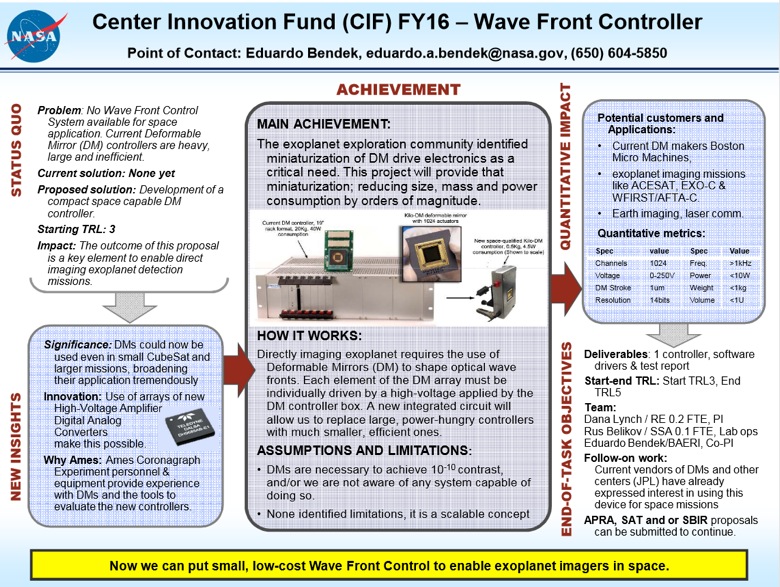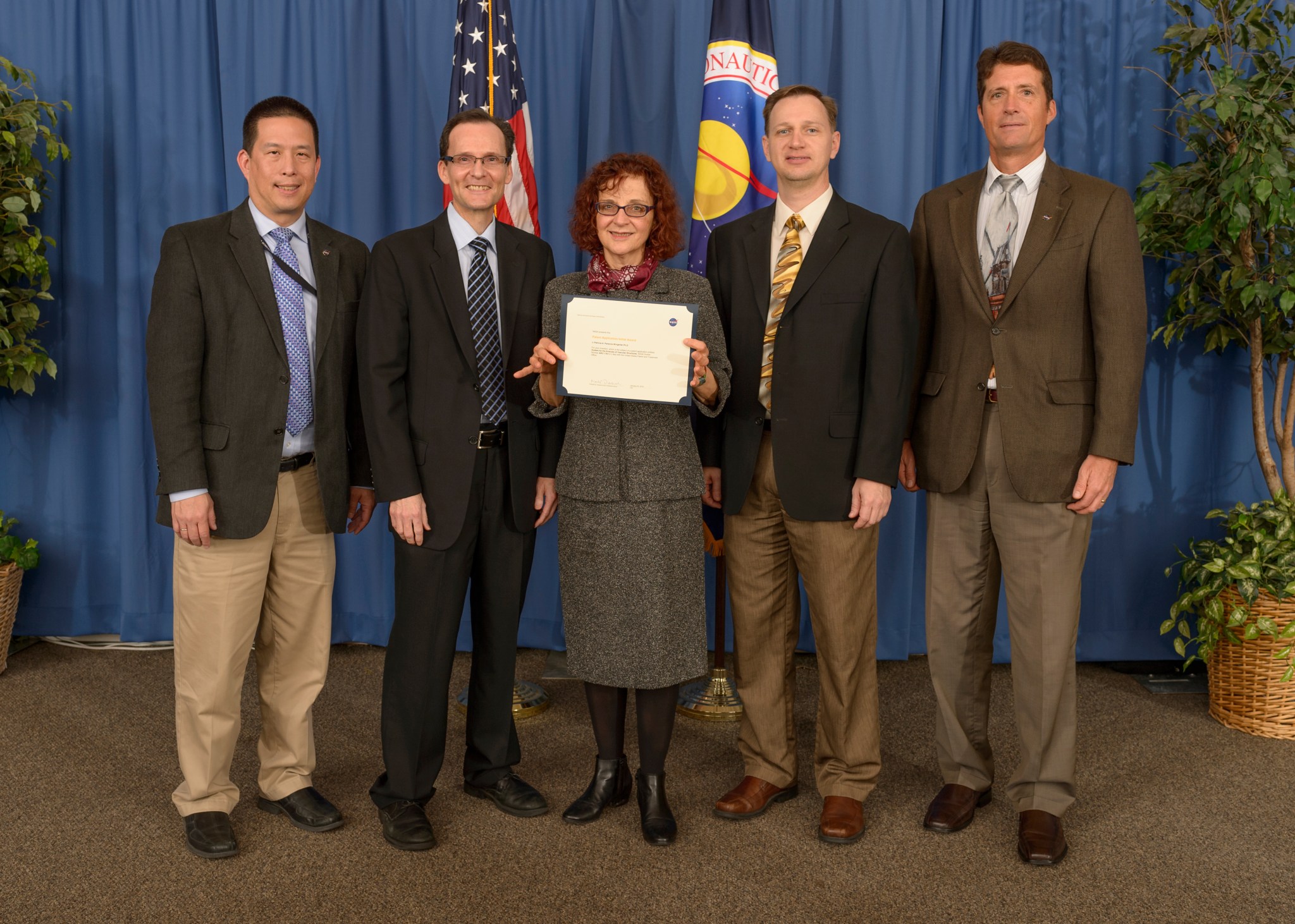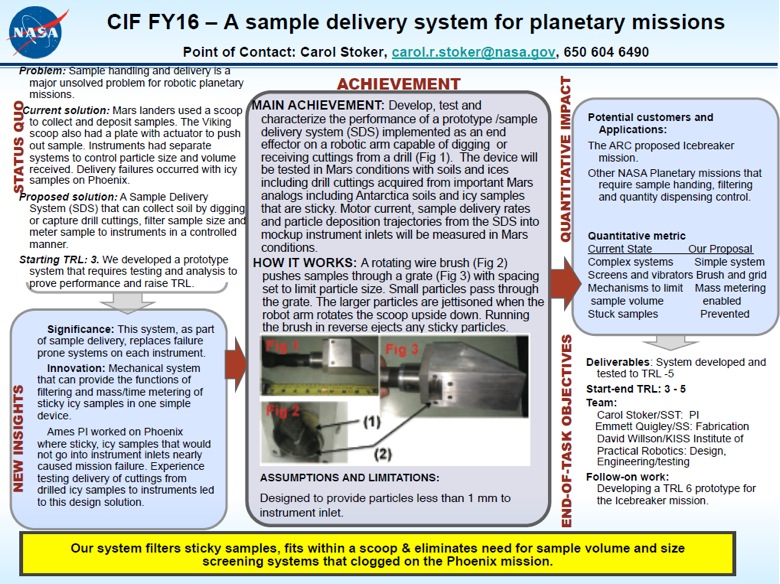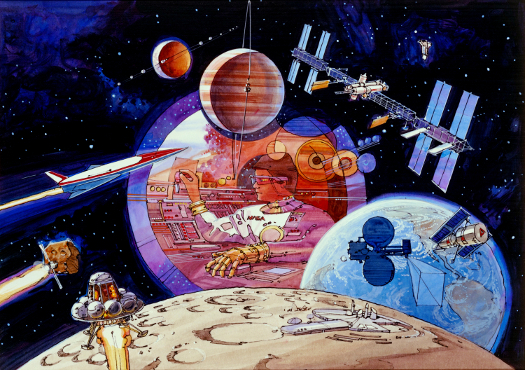2016 CIF Winner details
The Ames Center Chief Technologist Office selected 12 proposals to fund using the 2016 Center Innovation Fund (CIF).
We received about 50 proposals in response to the FY16 CIF call, which, again, generated some excellent concepts and resulted in a highly competitive selection process.
A panel comprised of science and technology experts from across the center reviewed the proposals using the following criteria: degree of innovation, including unique contributions to otherwise unmet Agency or National needs; technical merit; and effectiveness of resource planning and utilization. The CIF program at Headquarters provided a final vetting of all Center selections.
We were pleased by the response to this CIF call. The proposals underlined the fact that Ames researchers do creative and relevant work. We again tried this year to inform proposers of other opportunities to take their ideas forward.
We would like to thank the investigators who submitted proposals, the members of the review panel for their time and thoughtful evaluations of the proposals, and the CCT office staff for their support during all phases of the CIF process.
Please join us in congratulating the following 12 investigators chosen for the 2016 CIF:
Wave Front Controller
Principal Investigator: Eduardo Bendek
Multispectral Imaging, Detection and Active Reflectance (MiDAR)
Principal Investigator: Ved Chirayath
Co-Investigator: Ron Instrella
We present a novel remote sensing technique and instrument for Multispectral Imaging, Detection and Active Reflectance (MiDAR) with next-generation scientific capabilities for simultaneous in-situ, airborne and spaceborne measurements and optical communications. MiDAR consists of an active optical transmitter and passive receiver in monostatic and bistatic configurations. The MiDAR transmitter emits coded narrowband structured illumination to generate high-frame-rate multispectral video, perform real-time radiometric calibration and provide a high-bandwidth simplex optical data-link under a range of ambient irradiance conditions, including darkness. A theoretical framework, based on unique color band signatures, is developed for multispectral video reconstruction and optical communications algorithms used on MiDAR transmitters and receivers. Experimental tests demonstrate a 5-channel MiDAR prototype consisting of an active array of multispectral high-intensity light-emitting diodes (MiDAR transmitter) coupled with a state-of-the-art, high-frame-rate NIR computational imager, the NASA FluidCam NIR, which functions as a MiDAR receiver.
Preliminary results confirm efficient, radiometrically calibrated, high signal-to-noise ratio (SNR) active multispectral imaging in 5 channels from 405-940 nm at 2048×2048 pixels and 30 Hz. These results demonstrate a cost-effective and adaptive sensing modality, with the ability to change color bands and relative intensities in real-time, in response to changing science requirements or dynamic scenes. Finally, we discuss potential applications of MiDAR including high-resolution nocturnal and diurnal multispectral imaging from air, space and underwater environments as well as long-distance optical communication, bidirectional reflectance distribution function characterization, mineral identification, atmospheric correction, UV/fluorescent imaging, 3D reconstruction using Structure from Motion (SfM) and underwater imaging using Fluid Lensing. Multipurpose sensors, such as MiDAR, which fuse active sensing and communications capabilities, may be particularly well-suited for mass-limited robotic exploration of Earth and the solar system and represent a possible new generation of instruments for active optical remote sensing.
Project webpage: https://www.nasa.gov/earth-science-at-ames/what-we-do/las-laboratory-for-advance-sensing/las-midar-active-multispectral-imaging/
Provisional Patent Filed April 5, 2016 by NASA Ames, ARC-17697-1
AMES SWIR Camera (SWIRcam): A Spin-Off Of The Ames Imaging Module (AIM)
Principal Investigator: Tony Colaprete
We propose the development of a small Short-Wave Infrared (SWIR) imager that capitalizes on the development of the Ames Imaging Module (AIM), a CMOS camera developed through CIF (Fig. 1). The AIM electrical design provides radiation tolerance, even with commercial, non-radiation hardened parts, making it a very affordable science-quality imaging system that fits within a 1U cubesat space. The SWIR imager would have the same radiation tolerance as the AIM, but utilize the latest in InGaAs detector arrays providing sensitivity between 800 and 1700 nm, a very diagnostic range for mineralogy (Fig. 2) and volatiles (e.g., ices). Applications of a SWIR camera includes planetary surface observations for geochemical investigations (e.g., lunar or Martian surface missions), sample high-grading for in-situ analysis or sample return (e.g., South Pole Akin Basin sample return), or observations through atmospheric windows in thick atmosphere (e.g., Venus descent imaging). This type of camera can be combined with a spatial heterodyne spectrometer, or acousto-optic tunable filter, to create a simple hyperspectral imager with no moving parts (excellent for mapping a larger area or making atmospheric measurements), or combined with a series of LED emitters (as is now done with the AIM) to image at discrete wavelengths (excellent for identifying individual mineral types in a sample).
Critical Event Deconfliction for Interplanetary NanoSat Missions
Principal Investigator: Matt D’Ortenzio
The aim of this proposal is to demonstrate the applicability of ARC-developed planning & scheduling software to the challenge of scheduling deep-space communications assets in support of early-mission critical events for secondary payload missions, in particular deep-space and lunar NanoSats. Recognizing that the sheer number of upcoming missions may overwhelm the current systems, the proposed work is both critical and timely.
Until this point, NanoSat missions have been relegated to the low- or mid- Earth orbit regimes, where they are able to leverage a plethora of small ground antennas for telemetry and commanding and near-Earth infrastructures such as NORAD and GPS for tracking. Nearly all of these spacecraft have used amateur band radios allowing for additional supporting stations at very low cost. This is set to change with NASA’s next Space Launch System launch, which will send an Orion capsule on a trip to the Moon and back. In addition to Orion, the Exploration Mission 1 (EM-1), slated for launch in 2018, will carry between 13 and 17 individual NanoSats. Unlike their predecessors, these EM-1 NanoSats will target interplanetary trajectories with the goal of exploring a near-Earth asteroid (NEAScout), the Moon (Lunar Flashlight), and the deep-space radiation environment (BioSentinel), among other destinations. While these missions are truly exciting in nature, they mark a clear departure from previously flown NanoSat missions in several key ways. First, the inherent low-power nature of NanoSat transmitters, coupled with long distances, make NASA’s Deep Space Network (DSN, which is already over-subscribed) virtually a necessity. Second, achieving the desired trajectories requires navigation activities not needed for near-Earth NanoSats, namely time-critical propulsive maneuvers and radiometric tracking of the spacecraft, both of which require real-time communication with the ground. Many of these missions will require at least two propulsive maneuvers during the first six days of the mission, along with pre and post-maneuver tracking time, potentially requiring the DSN to support up to 30 critical events over the course of that span. Planning for launch slips and launch windows compounds the problem even further.
The proposal team has hands-on experience with a similar, but less complex problem: the co-manifested launch of the Lunar Reconnaissance Orbiter (LRO) and the Lunar CRater Observing and Sensing Satellite (LCROSS) in 2009. Construction of the first viable schedule that satisfied both mission’s objectives took over two months, and that result was only valid for one launch time, on one launch day, within one launch period. Once heuristics were established, development of schedules for subsequent launch cases accelerated; however out of the 84 possible launch scenarios, given their resources the team was only able to fully develop nine of them. Recognizing that this much effort was required for just a dual spacecraft launch (as opposed to 17), it becomes clear how overmatched the EM-1 NanoSat projects could be in this area without an intelligent software aid.
Safe Autonomous Flight Environment (SAFE50) for the Notional Last “50 ft” of Operation of “55 lb” Class of UAS
Principal Investigator: Kalmanje Krishnakumar
The most difficult phase of small UAS (Unmanned Aerial System) deployment is autonomous operations below 50 ft in urban landscapes. Understanding the feasibility of safely flying small UAS autonomously below 50 ft is a game changer for many civilian applications. Our R&D will substantially improve the use of small UAS and impact positively the economic growth of this promising potential. Safe and autonomous flight below 50 ft is hard due to: (1) Environmental uncertainties such as wind and dynamic obstacles; (2) Vehicle performance constraints posed by weight, size, and power limits and system failures; (3) Precision requirements for navigation and control is high; (4) Information-rich environment requiring real-time information fusion for decision-making combined with safe trajectory generation and management; (5) On-board autonomy operation in an infrastructure-free environment.
The figure on the right presents our target approach for solving the SAFE50 challenges. We have identified in the chart a list of uncertainties and constraints that have to be addressed and the information fusion and decision-making needed to enable safe flight. List items in red font require solutions beyond state-of-the-art, and items in black font reflect a solution space that includes some very good state-of-the-art approaches and/or solutions that will be implemented for this project.
Low Temperature Atmospheric Pressure Plasma Sterilization Shower
Principal Investigator: Meyya Meyyappan
Biological and organic terrestrial contamination of Martian atmosphere and/or terrestrial space through manned mission and backward biological contamination of earth through returning crew/spacecraft from other planets are issues of serious concern. We are proposing a novel and cost effective atmospheric pressure plasma based sterilization process to address both forward and backward biological contamination issues associated with manned as well as unmanned missions.
Critical 2D-to-3D Transformation of NASA’s VESGEN Software for Astronaut Health Countermeasures and Terrestrial Medicine/Ecological Commercialization
Principal Investigator: Patricia Parsons-Wingerter
Complex 3D branching vascular systems are required for all higher terrestrial life forms, including humans, other vertebrates, insects and dicot plants such as maple, oak and herbs. In 2005 NASA began developing the innovative VESsel GENeration Analysis (VESGEN) 2D software with a startup award to the PI. VESGEN 2D maps and quantifies vascular remodeling for a wide variety of quasi-2D vascularized biomedical tissue applications. The globally requested VESGEN 2D is acknowledged by numerous NASA and NIH peer-reviewed grant awards, publications and journal cover illustrations. For the CIF we propose to transform VESGEN from 2D to 3D, a frequently requested commercializable capability recommended by ARC’s Technology Partnerships. Although quasi-2D vascular applications in tissues such as the human and rodent retina, gastro-intestinal system (GI) and leaves of higher plants are important for biomedical and ecological research and imaging, by far the vast majority of vascularized organs and tissues in the human and vertebrate body are 3D, including the liver, brain, and more complete retinal and GI structures. Vascular-dependent diseases include cancer, diabetes, coronary vessel disease, and major astronaut health challenges in the space microgravity and radiation environments, especially for long-duration missions.
The PI currently has 3 active NASA and NIH grants. For example, we are using VESGEN 2D for astronaut retinas pre- and post-flight to the ISS to address the high-priority astronaut health risk established by the Human Research Program for NASA’s Exploration Medical Capabilities (ExMC), visual impairments associated with increased intracranial pressure (VIIP). Important vascularized models for Space Biology experiments on the ISS, nanosatellites and ARC’s new GeneLab and Rodent Research Facilities include the mouse retina and GI, wings of the fruitfly (Drosophila melanogaster) and leaf venation in plants such as thale cress (Arabidopsis thaliana). Our mature, beta-level, automated VESGEN software has been requested globally by approximately 145 potential users at research and technology development institutions that include Harvard Medical School, Mayo Clinic, the US Environmental Protection Agency (EPA), and NASA’s international partnering countries such as Germany and Brazil. Our mature, beta-level VESGEN 2D software is ready for final development by external beta testing and other software release methods. The Ames Technology Partnerships and Legal IP Offices are working actively together with the PI as Lead VESGEN Innovator to protect and further develop licensing and other funding opportunities. However, our current highly competitive research awards from NASA and NIH (top 3% score) are necessarily restricted to the analysis of 2D clinical images of retinal blood vessels in astronauts, NASA research subjects, and patients diagnosed with diabetic retinopathy. We therefore seek CIF seed funding to develop VESGEN 3D as an innovative software platform and breakthrough technology that will allow us to interact as middleware with ever-advancing 3D biomedical imaging that include OCT angiography for the retina, intravital GI imaging, CT for the placenta and organs such as the liver and brain.
Spectral Mass-Gauging of Unsettled Liquid with Acoustic Waves
Principal Investigator: Andre Petukhov
The ability to quickly gauge the amount of available propellant in a large-scale cryogenic propellant tank is one of the basic requirements of a successful tank design. Under settled conditions, a range of accurate mass-gauging techniques are available. However, propellant mass-gauging becomes a significant challenge under microgravity, since in this case both the location and shape of the ullage are a priori unknown. Presently, there are no technological solutions capable of determining the volume of unsettled liquid propellant in a large-scale cryogenic tank to within a few per cent accuracy. Such technology is needed, e.g., for the Space Launch System (SLS), where we would want to know the upper stage propellant mass in unsettled conditions. This would eliminate the need to perform a settling burn to measure the propellant mass, and determine how much propellant has boiled off after several months in space. We propose to develop a measurement protocol, using acoustic waves, and a computational algorithm based on rigorous mathematical results from spectral theory, that would enable measurement the volume of the ullage for unsettled liquid in micro and zero-gravity.
Shaped and Seamless Thermal Protection System
Principal Investigator: Thomas Squire
Most current thermal protection system (TPS) materials, used for spacecraft heatshields, must be applied in sections or tiles, which result in the presence of gaps, seams and joints. The design and implementation of these features are often challenging and require substantial resources. In addition, sharp angles and tight clearances can make the process of machining or forming TPS parts very difficult, especially if the material is mechanically weak. We propose to use knitted material technology to solve this problem for complex parts, especially for low heat flux conditions such as on reentry vehicle back shells, where there may be intricate shapes or holes required to be fitted. Knitted materials are compliant in all three material directions, making it easier to shape and fit them into spaces or onto substrates. Potential applications include protrusions, complex geometries, gaps, and seals. The thickness of knitted parts will depend upon the fibers, the knitting machine, and any filler used. The knitted material can also be fitted onto a substrate and infiltrated with a resin to form a part that could be rigid or compliant.
Knitted TPS will fill the TPS gaps between rigid solid parts, conformable materials made from felts, and highly capable woven TPS. Knitted fabrics differ from woven fabrics in that the yarn is continuous and there are no loose ends. They are flexible and exhibit drape, the ability to conform to rounded or curved shapes without creases or folds.
A Sample Delivery System for Planetary Missions
Carol Stoker (S)
Nano-ADEPT Lifting: Design Development for a Lifting Flight Test Demonstration
Principal Investigator: Paul Wercinski
The ADEPT entry architecture, a mechanically deployable entry system intended to achieve low ballistic coefficients (< 50 kg/m2) is a mid-TRL technology development project funded through the STMD Game Changing Development Program. The ADEPT project has focused on ballistic, axisymmetric shapes as the logical ‘first step’ in mission infusion applications. With the current maturation and development of the ballistic Nano-ADEPT, the next step in the ADEPT maturation is the focus on configurations that are capable of generating lift in order to accomplish aerocapture and precision landing EDL trajectories. The longer-term development capability goal for the Lifting ADEPT architecture is the delivery to Mars surface of Human Exploration scale payloads. This capability would have application for numerous robotic exploration missions as well.
Our external partner for the Lifting Nano-ADEPT Concept CIF Proposal is the Johns Hopkins University Applied Physics Laboratory (APL) which has identified unique planetary missions utilizing the Lifting Nano-ADEPT architecture for mission infusion in the near and mid-term (< 10 years) timeframe. APL will be contributing to this proposal with internal funding, independent of the CIF fund source. (APL Commitment Letter included with this proposal)
Only cursory level studies have looked at lifting ADEPT but have not looked at specific details of what physical configurations are needed and practical to generate lift and what options are feasible for implementing lift-vector roll-control, and/or lift/drag active modulation to best achieve guided lifting hypersonic flight.
The goal this CIF activity would be a flight test concept of possible Earth-based Lifting Nano-ADEPT flight test opportunities. With our APL partners, it is the intent to seek stakeholder support, eg STMD, and resources to pursue Lifting Nano-ADEPT flight test opportunities.
Raising the Technical Readiness of Germanium Immersion Gratings for a Space-based High-resolution Infrared Spectrometer
Principal Investigator: Peter Zell
High-resolution infrared (IR) spectrometers are currently too large and heavy for use in space, above the interference of the Earth’s atmosphere. This limits our ability to study key gas-phase molecules (such as H2O, CH4 and CO2) within interesting objects such as rotating protoplanetary disks. An IR spectrometer with a resolution of around 30,000 located in space would provide astronomers with a powerful tool to identify these gas molecules, define their abundance, determine their temperature, and evaluate their relative velocity within the object. High spectral resolution also enables improved study of star and planet formation, astro-chemistry, and will eventually be required to probe the atmospheres of extra-solar planets.
Included in the project proposal is an example of science data collected using the EXES high resolution IR spectrometer from the stratosphere on SOFIA (see Indriolo et al; 2015ApJ…802L..14I). These data show spectra from the massive protostar AFGL 2591 (black) and the reference star Vega (red). Absorption features common to both come from H2O within Earth’s atmosphere above SOFIA. The arrow indicates absorption toward AFGL 2591 out of the ground state of H2O, so probes the coldest water vapor. From this example, we see two major impediments to pursuing this type of science that will not be an issue for an eventual Ge immersion-grating-equipped satellite: even from the stratosphere, molecules in Earth’s atmosphere limit observations of certain wavelengths, and current high-resolution studies are restricted to the brightest objects. From a cold, space telescope, we will be above the entire atmosphere and the dramatically reduced number of background photons and the 24/7 observing cycle will enable high-resolution IR spectroscopy of a host of new objects.






























